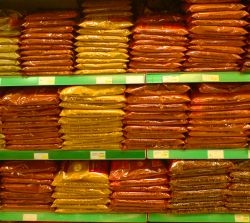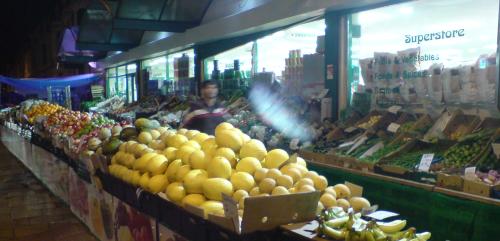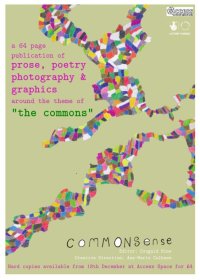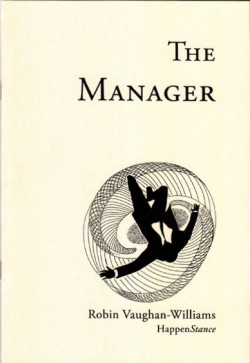I was really looking forward to the gothic storytelling night at Ye Olde Trip to Jerusalem (the oldest inn in England, according to their website) this evening, but ended up criss-crossing Nottingham city centre until I’d passed pretty much every pub except Ye Olde Trip, which turned out to be more or less where Google Maps had told me it was, only slightly to the south of where I was looking. What a pity! Still, I can now tell you where The Hole in the Wall, The Turf Tavern, the similar-sounding Ye Olde Salutation, and plenty of other pubs that don’t have storytelling nights are. But it looks like I’ll have to wait another month to get my narrative fix.

Look at all those spices...
Compensation came in the form of the wonderful Sharif & Sons Superstore on the corner of Radford Road and Gregory Boulevard. I’ve cycled past several times and been blown away by the vegetable section that lines the entire front of the shop, market style. They’ve got at least four different kinds of aubergines—the small thin Pakistani type that are good for cooking whole in bakes, slightly larger rounder egg-shaped aubergines (hence ‘egg plant’), white ones, and the large type you usually see in the UK. They’ve got loads of kinds of melons, papaya, large mangoes for 99p, and lots of other stuff that I would have crammed into my paniers if only I could.
Inside I drifted about in a daydream, my fruitless search for the oldest pub in England long forgotten, as I marvelled at the site of shelf upon shelf neatly stacked with what can only be described as sacks of spices—yes sacks…1kg packs of paprika, cayenne pepper, tandoori, and turmeric. Breakfast will never be the same again.

...and look at all that fruit!
Tuesday was Speak Easy (see their out-of date blog) in Sheffield’s Drum, now called the Hubs, formerly the National Centre for Popular Music, which was founded back in that brief spell when the government decided that museums ought to make money. And of course it didn’t make any money, so it closed. It was good to see the place being used. There was poetry in the A-pod, comedy in B-pod, some kind of dance or yoga class in C-pod, and…well, I’ll leave you to imagine what goes on in P-pod.
There was a good mix of poets and assorted performers, including Corncrake with his Kaoss pad, best described as a little magic box that seemingly dispenses with the need for any kind of band and opens up new vistas of intra-personal collaboration. The last time I saw one of those was in the hands of Morten Søndergaard at the 2009 Nýhil International Poetry Festival, who used it to render linguistic noise (see my blog post on that night).
There were the choo-choo train rhythms of Matt Black‘s ‘strategy-policy-procedure’ poem, which recreates that committee-meeting feeling of being swept along by something you’re not quite in control of, Stan Skinny doing something great on guitar, though I can’t remember what now, and some classic storytelling circularity and gallows humour from Tim Ralphs. I also enjoyed a poem someone read about old-fashioned names that have slipped out of fashion, which largely consisted of lists of names that transported me back to the childhood adventure landscape of Enid Blyton novels. And then of course there was me doing The Manager.
The main feature of the night was the horrendous teapot, which is the Speak Easy crew’s answer to the perennial problem of open-mic organisers—how do you keep people from going over the limit. When someone reaches 5 minutes, the T-pot is gently held aloft, rocks back and forth a few times, then a knife is raised and tapped against the T-pot in time with the poetry or music that has as yet failed to cease. If the scoundrel continues to hog the stage, then the clanging gets louder and faster and the T-pot is brought right up to the poor sod’s ears until they are chased back where they belong.
It is the most horrible way of keeping people to time I have ever seen, but seems to be exercised fairly, with no favours shown to anyone, however popular they might be, and that somehow seems to mitigate its nastiness—you know it’s nothing personal. There’s also something quite entertaining about watching someone being hounded off-stage by a T-pot. But it is a very ugly T-pot.

